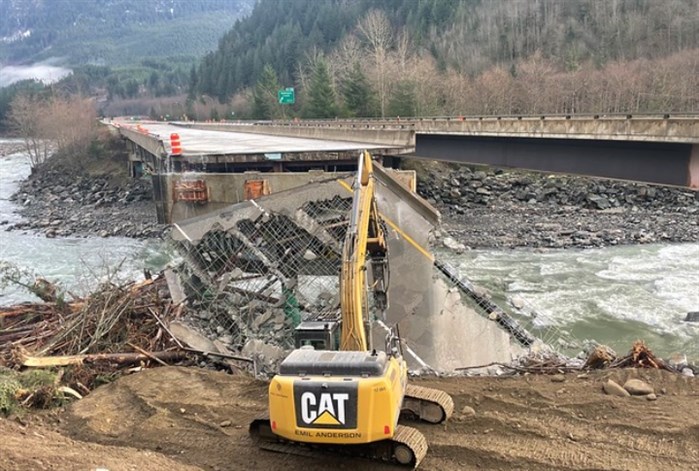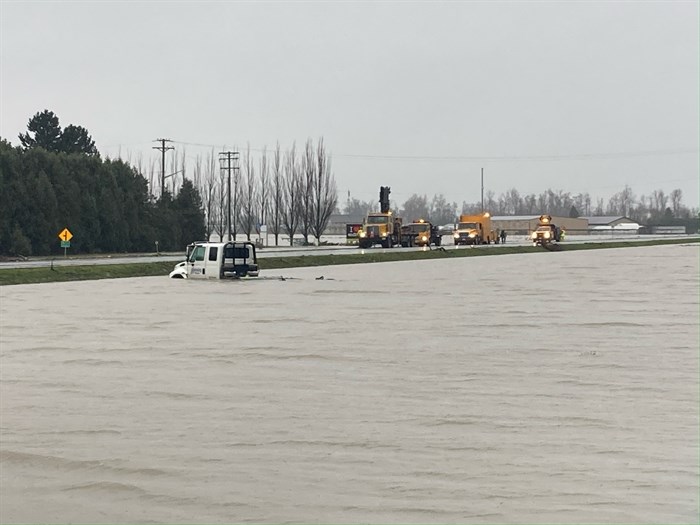
Road workers are replacing damaged infrastructure on the Coquihalla Highway with temporary measures.
Image Credit: Flickr/Ministry of Transportation and Infrastructure
November 25, 2021 - 6:00 PM
As repairs continue across the southern portions of B.C. after devastating floods, the province is preparing for another sweep of storms to hit the Lower Mainland through to next week.
The first two of three "pulses" are expected to bring normal November storm rainfall, but the third is expected to bring the most intensity, according to Public Safety Minister Mike Farnworth.
It's too early to accurately gauge how much precipitation will come, but the storm originating from the Philippines is expected to arrive over B.C. on Tuesday, Nov. 30.
Meanwhile, Farnworth urged the public at a Nov. 25 press conference to prepare for the possibility of evacuations in flood plain areas.
"Make sure your vehicle is prepared with food, water and warm clothes," he said, adding that people should use flood mitigation at their homes and clean drainages in preparation.
While leisure and non-essential travel remains restricted on many B.C. highways, there is progress on reopening roadways for essential and commercial traffic.
Highway 1 has been reopened as of today, Nov. 25, through the Chilliwack to Abbotsford corridor, while work continues on the Coquihalla Highway.
"We hope and expect Highway 1 will be able to remain open," Transportation and Infrastructure Minister Rob Fleming said at the press conference. "We will constantly monitor, and may have to close it again because safety is the number one priority."
After geotechnical assessments, the highway has been deemed safe for travel, even after being inundated with flood waters for several days.
Electrical lines connecting lights and variable speed limit signs are also still in working condition, Fleming said, so those will operate as normal.
He added, however, that the grassy medians and shoulders are wet and "swamp-like," so motorists than can travel on that road for essential reasons should use caution.
Speed limits on Highway 1 will also be reduced.
The Coquihalla Highway, however, will not be open until late-January, according to Fleming.

Water is still deep near Highway 1 near Abbotsford, but the road was reopened for essential travel at 2 p.m., Nov. 25.
Image Credit: TWITTER/Ministry of Transportation and Infrastructure
At least five temporary bridges will be installed, the Coquihalla River must be rerouted in some areas and other at-risk areas are being rebuilt because of the potential for future slides.
In areas that are generally more dangerous due to winter conditions, like Larsen Hill, the Coquihalla Summit and near the Great Bear Snowshed, have not been compromised by flooding or landslides.
When the Coquihalla does open with temporary measures, it will still be restricted to essential and commercial traffic.
Fleming could not estimate a time when non-essential traffic would be permitted again on the major mountain pass, but added weather will be a factor in determining if the late-January reopening date is accurate.
Highway 8, however, is so badly damaged that the Province may consider rerouting it away from the Nicola River entirely once more accurate assessments are completed.
Highway 3 continues to be the major route for essential travel between the Lower Mainland and the Interior, especially for large commercial trucks.
That area, especially around Princeton, continues to grapple with flooding and unstable ground, as the Okanagan Similkameen Regional District issued an evacuation alert for several properties south of Princeton.
The alert includes properties bordering both the Tulameen and Similkameen rivers.
For those who have already been evacuated, the Canadian Red Cross has offered $2,000 in assistance for people affected by recent flooding. Half of that amount will come from the province.
While the call centre has been experiencing backlogs, Farnworth said there is no deadlines and urges evacuees to have patience as the Red Cross works to address the situation.
Flooding this November is a reminder of the very recent wildfire season recently experienced, and Municipal Affairs Minister Josie Osborne said all levels of government will have to work together to build back from these natural disasters, while mitigating for the future.

Flood damage to Highway 8 is so extensive, the road may have to be rerouted away from the Nicola River entirely.
Image Credit: Flickr/Ministry of Transportation and Infrastructure
"It's rare that we have to respond to disasters like this both in the number and scale of what we've seen," Osborne said. "And we know they are related to climate change."
She said the province is working with the federal government to fund rebuilding efforts, while municipalities can also apply for funding to repair critical infrastructure that's been affected.
Go here for more information from the B.C. government on how to prepare for floods.
Go here for up to date highway information from DriveBC.
To contact a reporter for this story, email Levi Landry or call 250-819-3723 or email the editor. You can also submit photos, videos or news tips to the newsroom and be entered to win a monthly prize draw.
We welcome your comments and opinions on our stories but play nice. We won't censor or delete comments unless they contain off-topic statements or links, unnecessary vulgarity, false facts, spam or obviously fake profiles. If you have any concerns about what you see in comments, email the editor in the link above.
News from © iNFOnews, 2021